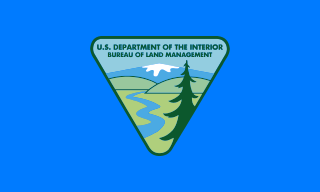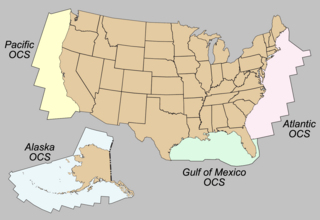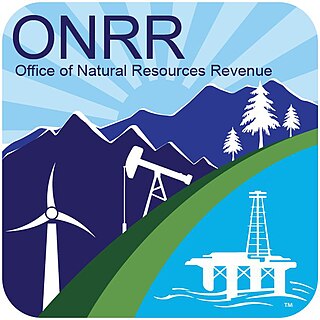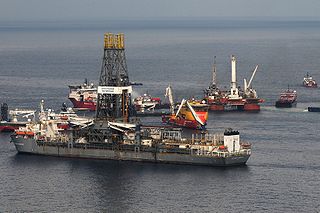
The Bureau of Land Management (BLM) is an agency within the United States Department of the Interior responsible for administering U.S. federal lands. Headquartered in Washington, D.C., the BLM oversees more than 247.3 million acres (1,001,000 km2) of land, or one-eighth of the United States's total landmass.
The Cape Wind Project was a proposed offshore wind energy project on Horseshoe Shoal in Nantucket Sound off Cape Cod, Massachusetts. It was projected to generate 1,500 gigawatt hours of electricity a year at a first-dollar cost of $2.6 billion.
Oil and gas law in the United States is the branch of law that pertains to the acquisition and ownership rights in oil and gas both under the soil before discovery and after its capture, and adjudication regarding those rights.

The Outer Continental Shelf (OCS) is a legally defined geographic feature of the United States. The OCS is the part of the internationally recognized continental shelf of the United States which does not fall under the jurisdictions of the individual U.S. states.

Rigs-to-Reefs (RTR) is the practice of converting decommissioned offshore oil and petroleum rigs into artificial reefs. Such biotic reefs have been created from oil rigs in the United States, Brunei and Malaysia. In the United States, where the practice started and is most common, Rigs-to-Reefs is a nationwide program developed by the former Minerals Management Service (MMS), now Bureau of Safety and Environmental Enforcement (BSEE), of the U.S. Department of the Interior.

Offshore oil and gas in the United States provides a large portion of the nation’s oil and gas supply. Large oil and gas reservoirs are found under the sea offshore from Louisiana, Texas, California, and Alaska. Environmental concerns have prevented or restricted offshore drilling in some areas, and the issue has been hotly debated at the local and national levels.

Offshore drilling for oil and gas on the Atlantic coast of the United States took place from 1947 to the early 1980s. Oil companies drilled five wells in Atlantic Florida state waters and 51 exploratory wells on federal leases on the outer continental shelf of the Atlantic coast. None of the wells were completed as producing wells. All the leases have now reverted to the government.

Offshore oil and gas in the Gulf of Mexico is a major source of oil and natural gas in the United States. The western and central Gulf of Mexico, which includes offshore Texas, Louisiana, Mississippi, and Alabama, is one of the major petroleum-producing areas of the United States. Oil production from US federal waters in the Gulf of Mexico reached an all-time annual high of 1.65 million barrels per day in 2017. Oil production is expected to continue the upward trend in 2018 and 2019, based on ten new oil fields which are planned to start production in those years. According to the Energy Information Administration, "Gulf of Mexico federal offshore oil production accounts for 15% of total U.S. crude oil production and federal offshore natural gas production in the Gulf accounts for 5% of total U.S. dry production."
Chris Craig Oynes was an American lawyer and federal government administrator.

The Bureau of Ocean Energy Management (BOEM) is an agency within the United States Department of the Interior, established in 2010 by Secretarial Order. The oil, gas, and renewable energy related management functions formerly under the purview of the Minerals Management Service (MMS) were delegated to the BOEM and its sister agency, The Bureau of Safety and Environmental Enforcement. Specifically, BOEM is involved in resource evaluation, planning, and leasing.

The Bureau of Safety and Environmental Enforcement is an agency under the United States Department of the Interior. Established in 2011, BSEE is the lead agency in charge of improving safety and ensuring environmental protection relating to the offshore energy industry, mainly natural gas and oil, on the United States Outer Continental Shelf (OCS). The agency exercises the safety and environmental enforcement functions formerly under the Minerals Management Service including the authority to inspect, investigate, summon witnesses and produce evidence, levy penalties, cancel or suspend activities, and oversee safety, response, and removal preparedness.

The Office of Natural Resources Revenue (ONRR) is a unit of the United States Department of the Interior, established by Secretarial Order. The new office exercises the royalty and revenue management functions formerly under the Minerals Management Service, including royalty and revenue collection, distribution, auditing and compliance, investigation and enforcement, and asset management for both onshore and offshore works.

Susan Elizabeth "Liz" Birnbaum served as Director of the Minerals Management Service in the United States from July 15, 2009, to May 27, 2010. Birnbaum was in charge of administering "programs that ensure the effective management of renewable energy [...] and traditional energy and mineral resources on the nation's Outer Continental Shelf, including the environmentally safe exploration, development, and production of oil and natural gas, as well as the collection and distribution of revenues for minerals developed on federal and American Indian lands."

Offshore oil spill prevention and response is the study and practice of reducing the number of offshore incidents that release oil or hazardous substances into the environment and limiting the amount released during those incidents.
Following is a Timeline of the Deepwater Horizon oil spill for May 2010.
Worst Case Discharge (WCD) is a calculation used by the Bureau of Ocean Energy Management, Regulation and Enforcement to determine the maximum flow rate for an offshore oil well in the event of an oil spill. WCD first came to prominence in the aftermath of the Deepwater Horizon Oil Spill to determine potential liability if another oil spill were to occur.
Oil spill governance in the United States is governed by federal law.
Charles Monnett is an American Arctic wildlife biologist with the U.S. Bureau of Ocean Energy Management, Regulation and Enforcement (BOEMRE), an agency of the U.S. Department of the Interior that manages the nation's natural gas, oil and other mineral resources on the outer continental shelf (OCS).

The Deepwater Horizon investigation included several investigations and commissions, among others reports by National Incident Commander Thad Allen, United States Coast Guard, National Commission on the BP Deepwater Horizon Oil Spill and Offshore Drilling, Bureau of Ocean Energy Management, Regulation and Enforcement, National Academy of Engineering, National Research Council, Government Accountability Office, National Oil Spill Commission, and Chemical Safety and Hazard Investigation Board.

The Lowering Gasoline Prices to Fuel an America That Works Act of 2014 is a bill that would revise existing laws and policies regarding the development of oil and gas resources on the Outer Continental Shelf. The bill is intended to increase domestic energy production and lower gas prices.

![Inspector General Earl Devaney gave testimony on his investigation of the MMS gifts scandal: "I think there is a bar [against corporations offering gifts], but I think in this case a decision was made at the Department of Justice ... to approach the oil and gas people in a different way." Earl E. Devaney.jpg](http://upload.wikimedia.org/wikipedia/commons/5/57/Earl_E._Devaney.jpg)














